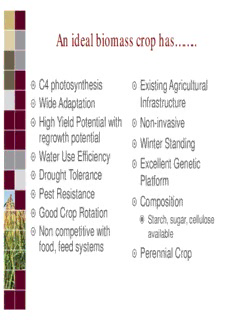
Bill Rooney (TAMU) - ARPA-e PDF
Preview Bill Rooney (TAMU) - ARPA-e
An ideal biomass crop has…….. C4 photosynthesis Existing Agricultural Wide Adaptation Infrastructure High Yield Potential with Non-invasive regrowth potential Winter Standing Water Use Efficiency Excellent Genetic Drought Tolerance Platform Pest Resistance Composition Good Crop Rotation Starch, sugar, cellulose ◉ Non competitive with available food, feed systems Perennial Crop C4 Bioenergy Grasses for the Southern U.S. Crop Growth Propagation History Biomass Notes Switchgrass Perennial Seed None Lignocellulose Problems w/ seed prod. & stand est. Sugarcane Perennial Cutting Sugar Sugar, cold sus. limits Lignocellulose range Miscanthus Perennial Rhizomes None Lignocellulose Propagation limited Sorghum Annual Seed Grain, Sugar, Starch Drought tolerance Forage Lignocellulose Source: UIUC Source: USDA NRCS Miscanthus Switchgrass Sorghum Sugarcane Big Country, Many Environments, Multiple Bioenergy Crops (Source: Department of Energy) Sorghum as a Bioenergy Feedstock Wide Adaptation High Yield Potential Water Use Efficiency and Drought Tolerance Existing Agricultural Infrastructure Multiple Types for Different Production Sorghum is the only crop to produce sugar, starch and ligno- ◉ cellulosic biomass Genetic Platform is available Annual Crop Bioenergy Sorghum Biomass Sorghum Sweet Sorghum Grain Sorghum Sweet Sorghum Some Grain Yield Juicy Stalk Highest concentrations of soluble sugar Highly variable for Maturities (photoperiod sensitivity) ◉ Types of Sugar ◉ Biomass and Sugar Yield ◉ Biomass Sorghums Strongly PS Do not flower ◉ Long Canopy Duration ◉ Enhanced Drought Tolerance ◉ Higher Yields ◉ Structural Carbohydrates Minimal Starch ◉ Lower Sugar ◉ Sorghum Improvement Grown as a Hybrid Crop Seed Parent ◉ Pollinator Parent ◉ Established methodologies applicable to all types of sorghum Genetic Diversity is the key Effective Phenotyping Critical 8 Sorghum Diversity Texas A&M Agrilife Research Breeding P u Exotic b l i Sorghum c R e s e a r c h R – Lines A/B – Lines P (Pollinator Parents) r (Seed Parents) i v a t e I n d u Good Energy Hybrids have 120 % High-Parent Heterosis s t r y Pedigree, Backcrossing, Population ◉ Winter nurseries – RGV, MX, PR ◉ Private Comp. Cooperative Testing ◉ Products: Germplasm and Parental Lines ◉
Description: